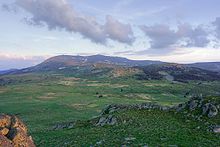
Back Інтрузія Byelorussian Intrusió Catalan Intrusión (geología) Spanish Intrusioon Estonian توده نفوذی آذرین Persian Intruusio Finnish Intrusi (geologi) ID Intruzija Lithuanian Intrusjon NN Intrusjon NB


In geology, an igneous intrusion (or intrusive body[1] or simply intrusion[2]) is a body of intrusive igneous rock that forms by crystallization of magma slowly cooling below the surface of the Earth. Intrusions have a wide variety of forms and compositions, illustrated by examples like the Palisades Sill of New York and New Jersey;[3] the Henry Mountains of Utah;[4] the Bushveld Igneous Complex of South Africa;[5] Shiprock in New Mexico;[6] the Ardnamurchan intrusion in Scotland;[7] and the Sierra Nevada Batholith of California.[8]
Because the solid country rock into which magma intrudes is an excellent insulator, cooling of the magma is extremely slow, and intrusive igneous rock is coarse-grained (phaneritic). Intrusive igneous rocks are classified separately from extrusive igneous rocks, generally on the basis of their mineral content. The relative amounts of quartz, alkali feldspar, plagioclase, and feldspathoid is particularly important in classifying intrusive igneous rocks.[9][10]
Intrusions must displace existing country rock to make room for themselves. The question of how this takes place is called the room problem, and it remains a subject of active investigation for many kinds of intrusions.[11]
The term pluton is poorly defined,[12] but has been used to describe an intrusion emplaced at great depth;[13] as a synonym for all igneous intrusions;[14] as a dustbin category for intrusions whose size or character are not well determined;[15] or as a name for a very large intrusion[16] or for a crystallized magma chamber.[17] A pluton that has intruded and obscured the contact between a terrane and adjacent rock is called a stitching pluton.
- ^ Philpotts, Anthony R.; Ague, Jay J. (2009). Principles of igneous and metamorphic petrology (2nd ed.). Cambridge, UK: Cambridge University Press. pp. 77–108. ISBN 9780521880060.
- ^ Blatt, Harvey; Tracy, Robert J. (1996). Petrology : igneous, sedimentary, and metamorphic (2nd ed.). New York: W.H. Freeman. pp. 13–20. ISBN 0716724383.
- ^ Blatt & Tracy 1996, p. 13.
- ^ Blatt & Tracy 1996, p. 14.
- ^ Blatt & Tracy 1996, p. 15.
- ^ Philpotts & Ague 2009, pp. 80–81.
- ^ Philpotts & Ague 2009, pp. 87–89.
- ^ Philpotts & Ague 2009, p. 102.
- ^ Le Bas, M. J.; Streckeisen, A. L. (1991). "The IUGS systematics of igneous rocks". Journal of the Geological Society. 148 (5): 825–833. Bibcode:1991JGSoc.148..825L. CiteSeerX 10.1.1.692.4446. doi:10.1144/gsjgs.148.5.0825. S2CID 28548230.
- ^ "Rock Classification Scheme - Vol 1 - Igneous" (PDF). British Geological Survey: Rock Classification Scheme. 1: 1–52. 1999.
- ^ Philpotts & Ague 2009, p. 80.
- ^ Winter, John D (2010). Principles of Igneous and Metamorphic Petrology. United States of America: Pearson Prentice Hall. pp. 67–79. ISBN 978-0-32-159257-6.
- ^ Blatt & Tracy 1996, p. 8.
- ^ Allaby, Michael, ed. (2013). "Pluton". A dictionary of geology and earth sciences (Fourth ed.). Oxford University Press. ISBN 9780199653065.
- ^ "Pluton". Encyclopædia Britannica. 19 January 2018. Retrieved 17 November 2020.
- ^ Levin, Harold L. (2010). The earth through time (9th ed.). Hoboken, N.J.: J. Wiley. p. 59. ISBN 978-0470387740.
- ^ Schmincke, Hans-Ulrich (2003). Volcanism. Berlin: Springer. p. 28. ISBN 9783540436508.
© MMXXIII Rich X Search. We shall prevail. All rights reserved. Rich X Search